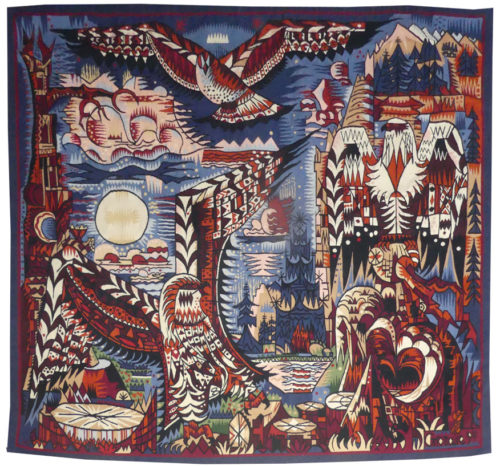Oiseaux de proie (Birds of prey)
Aubusson tapestry woven in the Goubely workshop.
With label, signed with stamp, and by the artit's son, n°6/6.
1941.
Gromaire’s woven pieces are few in number : 11 cartoons, designed between 1938 and 1944, most of them in Aubusson. “His rigorous construction, his use of simplification, his penchant for grand composition and grand fundamental ideas, his knowledgeable use of colour and in sum his supreme quality as a master-craftsman, all of those things were to make of him one of the most expert tapestry artists of his time”, so wrote Jean Cassou (Exhibition catalogue, Marcel Gromaire, Paris, Musée Nationale d’art moderne, 1963).
It was Guillaume Janneau, then in the chair of the Mobilier National, who contacted him in 1938, convinced that his style (simplification of shape, geometrical designs framed in black, influenced by cubism, limited colour schemes…) would have something to contribute to the resolution of the new aesthetic problems that the art of tapestry would have to confront in order to bring about its renewal (simplified palette, synthetic cartoon design...) firstly with a commission for a work on the theme of the four elements, then with a second (“les saisons”, the seasons) which would be produced at Aubusson. In 1940 Gromaire joined Lurçat and Dubreuil there. Working alone, with great meticulosity (numerous drawings anticipate the cartoon which is painted rather than numbered as with Lurçat), in close collaboration with Suzanne Goubely, who would weave all his cartoons, he spent 4 years in Aubusson, during which time he devoted all his creative energy to tapestry. At the end of the war, he left the Creuse and produced no more cartoons, leaving to Lurçat the position of grand initiator of the tapestry renewal movement.
« Oiseaux de proie » is one of the 5 tapestry cartoons designed by Gromaire for the Goubely workshop during the war and it is emblematic of his style : inspired by local landscapes, the absence of perspective, the strictly organised yet rich and highly abundant style, a limited palette (it is interesting to note the use at this period when France was occupied, the dominant colours of red, white and blue)... The atmosphere of this piece is more menacing than that of other pre-existing works.
Bibliography :
Tapisseries contemporaines Lurçat Gromaire, éditions Braun et cie, 1943, ill.
Le Point, Aubusson et la renaissance de la Tapisserie, mars 1946, ill. p.35
Jean Lurçat, Tapisserie française, Bordas, 1947, plate 25
J. Cassou, M. Damain, R. Moutard-Uldry, la tapisserie française et les peintres cartonniers, Tel, 1957
Exhibition catalogue, Gromaire, œuvre tissée, Aubusson, Musée de la tapisserie, 1995, reproduced on p. 49
Symposium Jean Lurçat et la renaissance de la tapisserie in Aubusson, Aubusson, Musée départemental de la tapisserie 1992, ill. n°14 (detail)
Exhibition catalogue La manufacture des Gobelins dans la première moitié du XXe siècle, Beauvais, Galerie nationale de la tapisserie, 1999.


